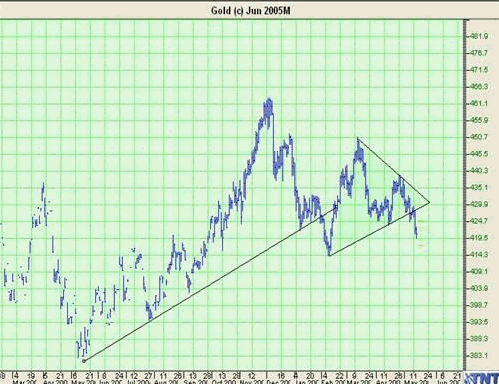Trade description
Buy four August Gold 400 puts and sell one August Gold 420 put for a credit of approx. $150. Margin is approximately $650 but can fluctuate depending on time value and market price. Options expire on 7/26/2005.
Explanation
Gold's recent breakdown off the several month pennant formation suggests increased volatility is on its way. Moreover, the market is at a critical price juncture, as it appears ready for some serious downside, but is also testing some technical support. This trade design provides for a highly leveraged bear play that is exposed for loss in a flat or slightly down market, but makes money in an up market and offers expansive profit potential on a break below $393.80.

Profit Scenarios
Max profit is unlimited and occurs at expiration as the market trades below 393.80. Profit is $300 per $1 move below 393.80 at expiration. Profit is $10 per .10 move above 418.50 to 420 ( or above) which is max profit to the upside at expiration ($150, or the credit received on the trade). It is recommended to scale out of one of the 400 puts for $550 and a second scale out at $900 to remove a majority of risk on the trade. Time value greatly increases profit potential as the market nears $400.
Risk Scenarios
Max risk is $1,850 (assuming an entry price of $150 credit) at expiration and occurs with the market at exactly 400. Loss is reduced by $100 per $1 move above 400 to 418.50 which is breakeven at expiration. Loss is reduced by $300 per $1 move below 400 at expiration down to 393.80 (breakeven). Using proper exit strategy by not holding the full position to expiration can greatly reduce the max risk. It is also recommended that you cover the 420 put on a gold rally for less than $300. This would create a reduced max risk of less than $150 and allow for the remaining time value to work in the 400 puts favor.
Why use ratio breakout spreads?
Ratio breakout spreads offer a unique opportunity to play a particular market definition. As with all option spreading techniques, each approach allows you to change your definition of market expectations from just up or down directional logic to a more complex and potentially probable scenario. The basic structure of a ratio breakout spread is to sell an in, at or near the money option and use the premium collected to buy multiple further out of the money options.
Using the recommendation above as an example, the trade is designed to benefit from a low underlying volatility in the market by buying out of the money puts, which are relatively discounted due to the market's speculative perception of downside potential in gold over the time frame of the trade, as well as overall low volatility suggesting the market perceives the potential for price spikes to the downside as unlikely. But buying cheap out of the money puts falls under the category of low probability option trading and one could easily argue that the majority of option traders that fail are buying OTM options. However, in this trade we sell a slightly in the money put to collect premium, as at or near the money options in a less than average volatility environment tend to hold a higher premium than OTM options. Since there is a net credit on the trade this allows the market to rally and achieve the credit received, or sell off dramatically to benefit from the leveraged ratio of puts (4 to 1 or a net of 3). Overall this trade design avoids paying over $500 for the long puts and wins in any market scenario that does not put gold between 393.80 and 418.50 come July 26th. Also, because the time value depreciation curve is quite sideways for the first 6 or 7 weeks of the trade, the play avoids the time value decay pitfall found in buying OTM options. If you compare the approach to being a straight buyer of 400 puts, you would find the following benefits and drawbacks:
Benefits
Stretched time value decay
More exit strategy choices - you can buy back the 420 put as described in the trade rec to essentially reposition the trade at a better price, scale out of the long puts at different price points, and even scale out of 3 puts to create a credit put spread to play the possible chop back up
Sells better premium collection and buys premium at a discount
Moves risk from cost of trade to a particular market scenario
Plays against a slight downtrend over time as opposed to straight put buying which plays against any move other than a strong selloff
Drawbacks
Not necessarily profitable on a slight down move
Exposed to larger total risk as time progresses than straight puts
Lower breakeven point at expiration
Margin can exceed the amount that would be required to just hold long 400 puts
Disclaimer
There is risk of loss in all commodities trading. Commissions and fees vary per individual and therefore are not included in profit, cost and risk scenarios. Please consult a licensed broker before you trade for the first time. Losses can exceed your account size and/or margin requirements. Commodities trading can be extremely risky and is not for everyone. Some option strategies have unlimited risk. Educate yourself on the risks and rewards of such investing prior to trading. James Mound Trading Group, or anyone associated with JMTG or moundreport.com, do not guarantee profits or pre-determined loss points, and are not held monetarily responsible for the trading losses of others (clients or otherwise). Past results are by no means indicative of potential future returns.
James Mound, owner of JMTG Brokerage LLC, MoundReport.com and author of the book 7 Secrets, writes the Weekend Commodities Review Newsletter. Receive your free weekly subscription to the Weekend Review by e-mail. Click here.